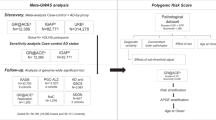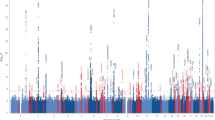Abstract
Although mutations in the β–amyloid precursor protein gene (APP) on chromosome 21 cause some cases of early–onset Alzheimer's disease (AD), most cases evidently do not have mutations in APP. We analysed ten early–onset families for linkage to APP and markers elsewhere in the genome. One family (F172) was consistent with linkage to chromosome 21 and was subsequently found to have an APP Val to lle mutation. Of the others, all but one were consistent with linkage to markers in the middle long arm of chromosome 14. However, no family showed independent evidence of linkage with two point analysis and only one showed independent evidence of linkage on multipoint analysis. Therefore, we cannot rule out heterogeneity at these loci although tests for heterogeneity were not significant.
This is a preview of subscription content, access via your institution
Access options
Subscribe to this journal
Receive 12 print issues and online access
$209.00 per year
only $17.42 per issue
Buy this article
- Purchase on Springer Link
- Instant access to full article PDF
Prices may be subject to local taxes which are calculated during checkout
Similar content being viewed by others
References
Masters, C.L. et al. Amyloid plaque core protein in Alzheimer disease and Down syndrome. Proc. natn. Acad. Sci. U.S.A. 82, 4245–4249 (1985).
Wong, C.W., Quaranta, V. & Glenner, G. Neuritic plaques and cerebrovascular amyloid in Alzheimer disease are antigenically related. Proc. natn. Acad. Sci. U.S.A. 82, 8729–6732 (1985).
Goate, A. et al. Segregation of a missense mutation in the amyloid precursor protein gene with familial Alzheimer's disease. Nature 349, 704–706 (1991).
Chartier Harlin, M.C. et al. Early onset Alzheimer's disease caused by mutations at codon 717 of the β-amyloid precursor protein gene. Nature 353, 844–846 (1991).
Murrell, J., Farlow, M., Ghetti, B. & Benson, M. A mutation in the amyloid precursor protein associated with hereditary Alzheimer's disease. Science 254, 97–99 (1991).
Mullan, M. et al. A pathogenic mutation for probable Alzheimer's disease in the APP gene at the N terminus of β-amyloid. Nature Genet. 1, 345–347 (1992).
Weitkamp, L.R., Nee, L., Keats, B., Polinsky, R.J. & Guttormsen, S. Alzheimer's disease: Evidence for susceptibility loci on chromosomes 6 and 14. Am. J. hum. Genet. 35, 443–453 (1983).
Abraham, C.R., Selkoe, D.J. & Potter, H. Immunochemical identification of the serine protease inhibitor alpha 1-antichymotrypsin in the brain amyloid deposits of Alzheimer's disease. Cell 52, 487–501 (1988).
Cox, D., Nakamura, Y. & Gedde-Dahl, T. Jr., Report of the committee on the genetic constitution of chromosome 14. Cytogenet. Cell Genet. 55, 183–188 (1990).
Wang, Z. & Weber, J. Continuous linkage map of human chromosome 14 short tandem repeat polymorphisms. Genomics 13, 532–536 (1992).
Ott, J. Analysis of Human Genetic Linkage (Johns Hopkins University Press, Baltimore, 1991).
Fidani, L. et al. Screen for mutations in the open reading frame and promoter of the beta-amyloid precursor protein gene in familial Alzheimer's disease: Identification of a further family with APP717 Val→lle. Hum. molec. Genet. 1, 165–168 (1992).
Schellenberg, G. et al. Genetic linkage evidence for a familial Alzheimer's disease locus on chromosome 14. Science 258, 668–671 (1992).
Glenner, G.G. & Murphy, M.A. Amyloidosis of the nervous system. J. neurol. Sci. 94, 1–28 (1989).
Selkoe, D.J. The molecular pathology of Alzheimer's disease. Neuron 6, 487–491 (1991).
Hardy, J.A. & Higgins, G.A. Alzheimer's disease: The amyloid cascade hypothesis. Science 256, 184–185 (1992).
Abe, K., St. George Hyslop, P.H., Tanzi, R.E. & Kogure, K. Induction of the amyloid precursor protein mRNA after heat shock in cultured human lymphoblastoid cells. Neurosci. Letts. 125, 169–171 (1991).
McKhann, G. et al. Clinical diagnosis of Alzheimer's disease: Report of the NINCDS-ADRDA Work Group under the auspices of Department of Health and Human Services Task Force on Alzheimer's disease. Neurology 34, 939–944 (1984).
Folstein, M.F., Folstein, S.E. & McHugh, P.R. “Mini Mental State”: A practical method for grading cognitive state of patients for the clinician. J. Psychiatr. Research 12, 189–198 (1975).
Lathrop, G.M. & Ott, J. Analysis of complex diseases under oligogenic models and intrafamilial heterogeneity by the LINKAGE programs. Am. J. hum. Genet. 47, A188 (abstr.) (1990).
Author information
Authors and Affiliations
Rights and permissions
About this article
Cite this article
Mullan, M., Houlden, H., Windelspecht, M. et al. A locus for familial early–onset Alzhelmer's disease on the long arm of chromosome 14, proximal to the α1–antichymotrypsin gene. Nat Genet 2, 340–342 (1992). https://doi.org/10.1038/ng1292-340
Received:
Accepted:
Issue Date:
DOI: https://doi.org/10.1038/ng1292-340
This article is cited by
-
Multifaceted Alzheimer’s Disease: Building a Roadmap for Advancement of Novel Therapies
Neurochemical Research (2021)
-
Population PKPD Modeling of BACE1 Inhibitor-Induced Reduction in Aβ Levels In Vivo and Correlation to In Vitro Potency in Primary Cortical Neurons from Mouse and Guinea Pig
Pharmaceutical Research (2014)
-
Effects of Single Doses of Avagacestat (BMS-708163) on Cerebrospinal Fluid Aβ Levels in Healthy Young Men
Clinical Drug Investigation (2012)
-
Comparison of Pharmacological Modulation of APP Metabolism in Primary Chicken Telencephalic Neurons and in a Human Neuroglioma Cell Line
Journal of Molecular Neuroscience (2011)
-
Neuropathology after active Aβ42 immunotherapy: implications for Alzheimer’s disease pathogenesis
Acta Neuropathologica (2010)



